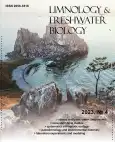Annual temperature regime of the shallow zone of Lake Baikal inferred from high-resolution data from temperature loggers
- 作者: Fedotov A.P.1, Khanaev I.V.1
-
隶属关系:
- Limnological Institute Siberian Branch of the Russian Academy of Sciences
- 期: 编号 4 (2023)
- 页面: 119-125
- 栏目: Articles
- URL: https://journal-vniispk.ru/2658-3518/article/view/292300
- DOI: https://doi.org/10.31951/2658-3518-2023-A-4-119
- ID: 292300
如何引用文章
全文:
详细
Annual changes in temperature characteristic of the shallow zone during 2017-2022 have been studied in this work. Dataset was contrasted based on 8 transects located in South, Central and Northern Baikal at depths of 3, 4, 6, 12, 15 and 26 m. Temperatures were measured every 1.5-3 hour. It was determined that modal values of maximal heating of the shallow zone at all stations and depths were 15-16°C, however, distribution of maximal temperatures of South Baikal shifted toward the low temperatures, and these maximums could be only 9-10°C. Temperature regime of the shallow zone during warm seasons is characterized by sharp changes due to wind mixing and upwelling, when temperature drops dramatically from 16-18°C to 4°C for the 1-1.5 day. In most cases, the duration of stabile temperature condition without wind mixing was 4 days. On average, upwelling events occurred 5 times (maximum - 13 events) from July to November. As a result of wind mixing, the shallow zone is characterized as moderately warm with average temperatures of 6-7°C from June to November. A temperature effect on the shallow zone of Lake Baikal due to the Global warming is smoothed by cooling of the zone by deep waters during upwellings.
作者简介
A. Fedotov
Limnological Institute Siberian Branch of the Russian Academy of Sciences
编辑信件的主要联系方式.
Email: mix@lin.irk.ru
俄罗斯联邦, 3 Ulan-Batorskaya Str., Irkutsk, 664033
I. Khanaev
Limnological Institute Siberian Branch of the Russian Academy of Sciences
Email: mix@lin.irk.ru
俄罗斯联邦, 3 Ulan-Batorskaya Str., Irkutsk, 664033
参考
- Domysheva V., Vorobyeva S., Golobokova L. et al. 2023. Assessment of the current trophic status of the Southern Baikal littoral zone. Water 15: 1-14. doi: 10.3390/w15061139
- Izhboldina L.A. 2007. Guide and key to benthonic and periphyton algae of lake Baikal (meio- and macrophytes) with short notes of their ecology. Novosibirsk: NAUKA. (in Russian)
- Kravtsova L., Vorobyeva S., Naumova E. et al. 2021. Response of aquatic organisms communities to global climate changes and anthropogenic impact: evidence from Listvennichny Bay of Lake Baikal. Biology 10: 1-22. doi: 10.3390/biology10090904
- Maximova N.V., Melnikova E.N., Shirokaya A.A. et al. 2012. Seasonal and inter-annual distribution of Gastropoda in three hydrodynamic stony littoral zones of Lake Baikal. Ruthenica 22: 1-14.
- Ozersky T., Volkova E.A., Bondarenko N.A. et al. 2018. Nutrient limitation of benthic algae in Lake Baikal, Russia. Freshwater Science 37: 472-482. doi: 10.1086/699408
- Potemkina T.G., Potemkin V.L., Kotsar O.V., Fedotov A.P. 2018. Climate factors as a possible trigger of modern ecological changes in shallow zone of Lake Baikal (Russia). International Journal of Environmental Studies. 75: 86-98. doi: 10.1080/00207233.2017.1406727
- Shimaraev M.N., Troitskaya E.S. 2018. Current trends in upper water layer temperature in coastal zones of Baikal. Geography and Natural Resources. 39: 349-357. doi: 10.1134/S187537281804008X
- Shimaraev M.N., Troitskaya E.S., Blinov V.V. et al. 2012. On upwellings in Lake Baikal. Doklady Earth Sciences 442: 272–276.
- Shimaraev M.N., Verbolov V.I., Granin N.G. et al. 1994. Physical limnology of Lake Baikal: a review. Irkutsk-Okayama: Baikal International Center for Ecological Research.
- Sitnikova T.Ya. 2006. Endemic gastropod distribution in Baikal. Hydrobiologia 568: 207-211.
- Timoshkin O.A., Samsonov D.P., Yamamuro M. et al. 2016. Rapid ecological change in the coastal zone of Lake Baikal (East Siberia): Is the site of the world’s greatest freshwater biodiversity in danger? Journal of Great Lakes Research 42: 487-497. doi: 10.1016/j.jglr.2016.02.011
- Troitskaya E., Blinov V., Ivanov V. et al. 2015. Cyclonic circulation and upwelling in Lake Baikal. Aquatic Sciences 77: 171-182. doi: 10.1007/s00027-014-0361-8
- Verbolov V.I., Pokatilova T.N., Shimaraev M.N. et al.1986. Formation and dynamics of Baikal waters. Novosibirsk: Nauka. (in Russian)
- Votintsev K.K. 1961. Hydrochemistry of Lake Baikal. In: Galaziy G.I. (Ed). Moscow: Publishing House of the Academy of Sciences of the USSR. (In Russian)
补充文件









